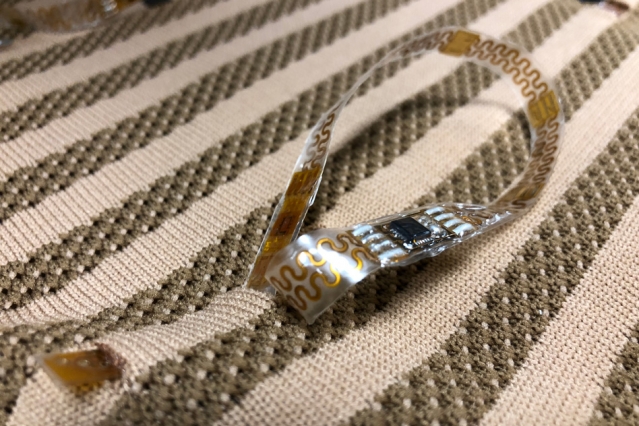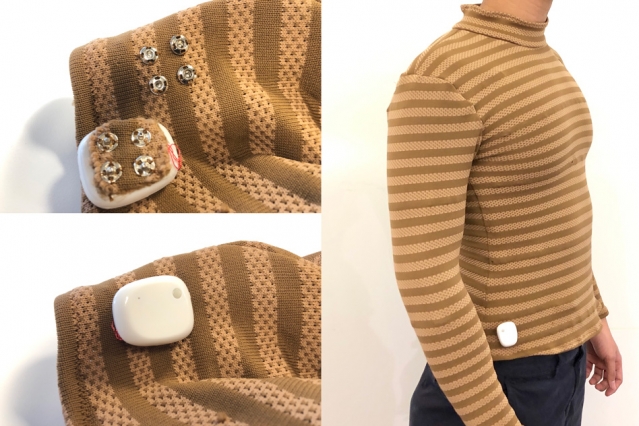By Gina Roos, editor-in-chief
Researchers at the Massachusetts Institute of Technology (MIT) have developed a technique to embed sensors into stretchy clothing fabrics, paving the way to monitor vital signs such as temperature, respiration, and heart rate as you go about your day. In addition, these form-fitting and sensor-embedded garments are machine-washable.
Researchers said that the garments could be used to remotely track a patient’s health, ranging from those ill at home or in a hospital to monitoring an athlete’s physical activity. It can also be useful for telemedicine, which is particularly useful now during the COVID-19 pandemic for doctors who are increasingly connecting with patients remotely.
“We can have any commercially available electronic parts or custom lab-made electronics embedded within the textiles that we wear every day, creating conformable garments,” said Canan Dagdeviren, the LG Electronics Career Development assistant professor of Media Arts and Sciences at MIT, in a statement. “These are customizable, so we can make garments for anyone who needs to have some physical data from their body like temperature, respiration rate, and so forth.”

The garments work by compression, with the sensors touching the skin. The sensors are removeable from the stretchy material and the clothing can be washed with the sensors embedded in them.
According to the researchers’ paper, published in scientific journal Nature, this textile platform can be customized in a variety of forms, sizes, and functions using standard high-throughput textile-manufacturing and garment-patterning techniques. Similar to a compression shirt, the stretchable electronic textile conformable suit (E-TeCS), as it’s called by researchers, allows contact between the electronics and the skin with a pressure of about 25 mmHg. Researchers said this allows for physical comfort and improved precision for sensor readings on skin.
The suit (garment) is tailored from a customized fabric that can be integrated with a variety of sensors and interconnects as flexible, stretchable electronic strips. The textile platform consists of channels or pockets for weaving these electronic strips.
The sensor ICs and interconnects are developed using two-layer industrial flexible printed circuit board (PCB) processes, said researchers, with additional steps for chip and passive component assembly and encapsulation with thermoplastic polyurethane (TPU) (TE-11C, Dupont) and a washable encapsulant (PE773, Dupont).
The E-TeCS can detect skin temperature with an accuracy of 0.1°C and a precision of 0.01°C, as well as heart rate and respiration with a precision of 0.0012 m/s2 , thanks to mechano-acoustic inertial sensing.
Researchers also found that the knit textile electronics can be stretched up to 30% under 1,000 cycles of stretching without significant degradation in mechanical and electrical performance.

Clothing provides an ideal platform for the integration of electronics to monitor physiological processes through the skin, said researchers. Therefore, electronic devices integrated into textiles can offer several advantages, such as enhanced mobility and comfort for users.
Researchers noted that there have been various efforts made to integrate electronics into textiles; however, many of them are not scalable for large-area sensing and don’t allow for “stretchability for the application of skin-contact sensing for electronic suits,” and most only measure a single parameter at a particular contact location.
MIT’s researchers have developed a technique that combines thin, customizable, and conformable electronic devices, including interconnect lines and off-the-shelf ICs, with plastic substrates that can be woven into knitted textiles using a high-throughput manufacturing approach. Like a compression garment, it provides contact between the electronics and the skin.
To demonstrate manufacturability, the researchers designed and fabricated seven different modules: four temperature-sensing modules, one inertial-sensing module, and two interconnection modules. They fit 66 temperature sensors and 20 interconnection strips on a 25 × 27.5-cm flexible board (FPCB, KingCredie).
In terms of the sensor network architecture embedded in the fabric, each sensor can be connected to each other with the interconnects horizontally, where the signal gets collected by the external layer, which consists of a Bluetooth Low Energy (BLE) module, a microprocessor, and a power source.
The team developed a prototype shirt to demonstrate the scalability of the sensor-integrated fabric. It shows the possibility of roll-to-roll manufacturing of sensor-embedded fabrics that can be cut in any size, joined, and tailored for a variety of needs and applications, said researchers.
The team plans to develop other types of garments such as pants and incorporate additional sensors for monitoring other health indicators such as blood oxygen levels.
For more information about the research and technology, watch the researchers’ video here.
Advertisement
Learn more about Electronic Products Magazine





